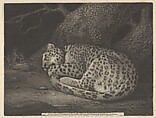A Sleeping Leopard
George Stubbs British
Not on view
Stubbs’s masterful ability to both describe animals and suggest their inner life is evident in the curled form of this unconscious great cat. Soft-ground etching, enhanced with roulette work, was used to create the inky darkness that cloaks the sleeping body. At several points, the profile of the animal’s body merges with the gnarled tree trunk at its back, while its open mouth echoes the rounded negative spaces between the branches above. Pushing the possibilities of his medium, Stubbs captured the distinct textures of bark, fur, and rocky ground using a limited tonal range. Lions, tigers, and leopards represented nature’s ferocity and evoked terror for eighteenth-century viewers, an emotion associated with the sublime.
Due to rights restrictions, this image cannot be enlarged, viewed at full screen, or downloaded.


